
Not only do strong glutes look great, but they also provide many benefits, as they are one of the most powerful muscle groups of the body! They assist with activities like walking, climbing stairs, sprinting, jumping, and squatting. Strong glutes can even help minimize lower back pain, so learning some of the best glute exercises for men is crucial!
The best glute exercises develop strength and size in one or more primary glute muscles: the gluteus maximus, gluteus medius, and gluteus minimus. The three gluteal muscles work together to extend the leg, stabilize the pelvis and hips, and abduct and rotate the leg, so strengthening your glutes can translate to improved athletic performance and overall movement efficiency. Ready to get started? Keep reading for the best glute exercises for men and get that strong, powerful booty looking and feeling top-notch!
Barbell back squats

Barbell back squats are one of the most effective ways to load the glutes with high resistance for ultimate strengthening and hypertrophy. For safety, make sure you understand the proper form or ask a trainer at your gym to instruct you. If you’re not comfortable using a barbell, you can use dumbbells.
Equipment: Barbell and weights or dumbbells
Execution
- Stand at a squat rack with the barbell positioned along with your upper traps, with your feet slightly wider than shoulder-width apart, your toes pointing forward, your core engaged, and your chest up and proud.
- Inhale while you bend your knees and sit your hips backward as if reaching your butt back to sit in a chair. Keep your back straight and chest up and proud.
- Lower your body until your thighs are parallel to the floor and your knees are bent 90 degrees. Your knees should not be extending forward beyond your toes.
- Exhale, pressing through your heels to return to stand back up.
- Complete 8-10 reps.
Walking single-leg Romanian deadlifts

This exercise activates your entire posterior chain, so it’s an excellent exercise for developing your glutes and hamstrings. Focus on engaging your glutes to help maintain your balance and drive the motion.
Equipment: Dumbbells or kettlebells
Execution
- Stand with your feet shoulder-width apart, knees slightly bent, chest up and proud, and arms at your sides while holding a dumbbell or kettlebell in each hand.
- Engage your core and glutes, then take a step forward with your left leg.
- Load into that leg by bending your left knee (the one on the standing/support leg) about 20 degrees to activate your glutes while you lift your right leg off the ground.
- Hinge from your hips to tilt your torso toward the floor, keeping your gaze down to prevent hyperextending your neck. Simultaneously, reach your right hand with the weight down towards your left foot until you feel enough of a stretch in the hamstrings of your supporting leg. Your right leg should extend behind you as a counterbalance, and your torso should be parallel to the floor.
- Contract your glutes to stand back up as you take the next step forward.
- Complete 12 steps per side.
Medicine ball single-leg bridges

Bridges are one of the most classic glute exercises. This variation is more challenging and requires greater glute activation.
Equipment: Medicine ball
Execution
- Lie on your back with your knees bent, one foot flat on the floor and one foot atop a medicine ball, and arms crossed over your chest.
- Lift one foot off the floor, so you are only pressing through the medicine ball foot.
- Squeeze your glutes to lift your hips up until they are in line with your body from your knees to your head.
- Hold and squeeze for one breath, then slowly lower.
- Repeat 15 times and then switch sides.
Weighted step-ups

Step-ups are one of the best lower-body strengthening exercises, and this move almost always deserves a spot in your lineup of leg workouts. Remember that if it’s hypertrophy you’re after (gaining size and muscle mass), you’ll want to go heavy on the weights and drop the reps. That said, be sure you can maintain proper form and complete each rep pain-free.
Equipment: Dumbbells and a plyometric box, step, or bench
Execution
- Stand facing a plyometric box, bench, or step that is roughly knee height or slightly lower. Hold a relatively heavy dumbbell in each hand with your arms down at your sides.
- Engage your core and glutes while you step up onto the box with your right foot, pressing through your heel to lift your body.
- Step your left leg up onto the box as well so that you’re standing on top of the box with both feet.
- Step back down backward with your right foot first and then your left foot.
- Continue leading with the right foot for 8-10 reps, and then switch sides.
Frankenstein shuffles
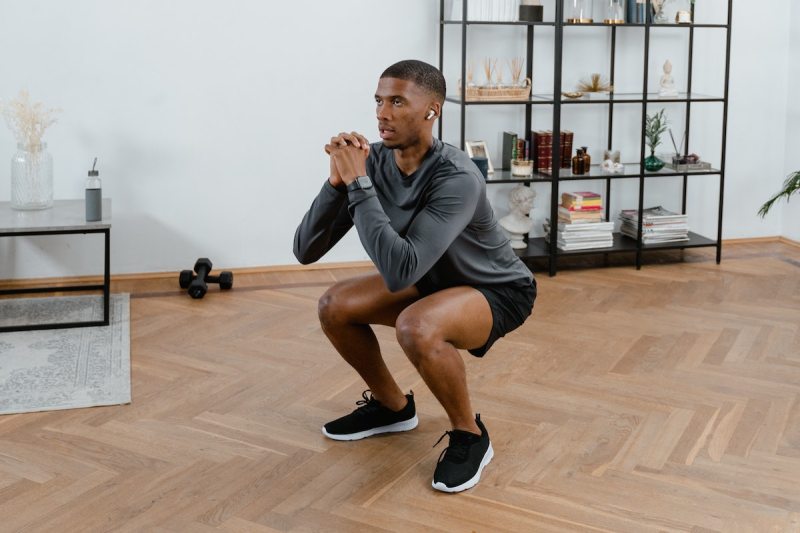
This move targets all three glute muscles while simultaneously working the quads and can be completed at home or outside if you don’t have access to a gym. Stay as low as possible throughout the movement to engage your entire lower body.
Equipment: Strong loop resistance band
Execution
- Place a resistance loop band around your ankles.
- Get into a good squat position with your feet slightly wider than shoulder-width apart, core engaged, chest up, shoulders back, hands on your hips, and knees bent to 90 degrees.
- Staying down in your squat position, step your right foot outward toward the right as far as you can.
- Follow the left foot over, but maintain tension on the band by keeping a good distance between your two feet.
- Walk to the one side 30 steps in total, striding as long as you can with each step and staying low to keep your quads engaged.
- Return by facing the same way and leading with the left leg.
Cable leg extensions

One of the primary functions of the glutes is to extend the leg, and this glute exercise is one of the best ways to target that function. You can perform it at home with a strong resistance band.
Equipment: Cable machine or resistance band anchored low to the ground.
Execution
- Attach the cable or resistance band to one ankle by using an ankle cuff.
- Face the upright post of the cable machine and hold on lightly for balance.
- Allow a slight bend in your stabilizing knee while lifting your leg with the ankle cuff and extending it directly behind your body, reaching back as far as you can.
- Squeeze your glute and hold this position for a second before returning it back to the starting position.
- Complete 12 reps before switching sides.
Trap bar deadlifts
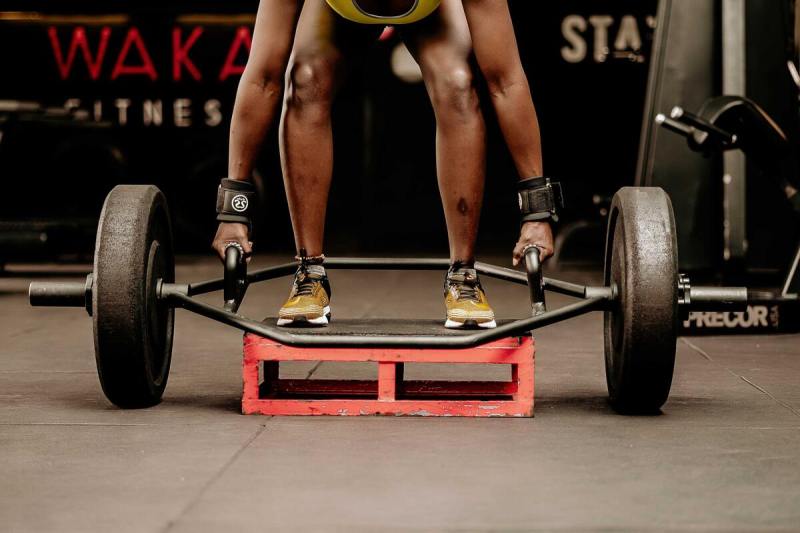
You can use a standard barbell for deadlifts, but a trap bar or hex bar allows you to use a neutral grip, which relieves stress on your upper body and allows you to lift more weight. The more weight you’re able to lift, the greater the load on your glutes, which better stimulates them to get bigger and stronger.
Equipment: Trap bar and weights
Execution
- Stand inside the loaded trap bar with your feet hip-width apart and your toes pointing forward.
- Brace your core as you squat down and grasp the handles on either side of the trap bar.
- Fire your glutes and hamstrings to extend your hips and knees to stand upright, keeping your back straight.
- Slowly lower the bar back to the floor by sitting your hips back.
- Complete 8-10 reps.
Single-leg barbell hip thrusts

This thrust exercise is one of the most effective glute exercises and a great way to load the glutes and develop power, strength, and size. At home, you can use dumbbells if you don’t have a barbell.
Equipment: Barbell or dumbbell
Execution
- Place your shoulder blades on the long side of a bench with your body bridging off the side so that your knees are bent 90 degrees, your feet are hip-width apart and flat on the floor, your core and glutes are engaged, and your hips are up in a tabletop position.
- Hold the barbell across your hips.
- Lift one foot off the ground so that you are only pressing through one foot.
- Raise and lower your hips toward the floor, reaching the top position where your thighs are parallel to the ground for each rep.
- Complete 10 controlled reps per set.
Deficit reverse lunges
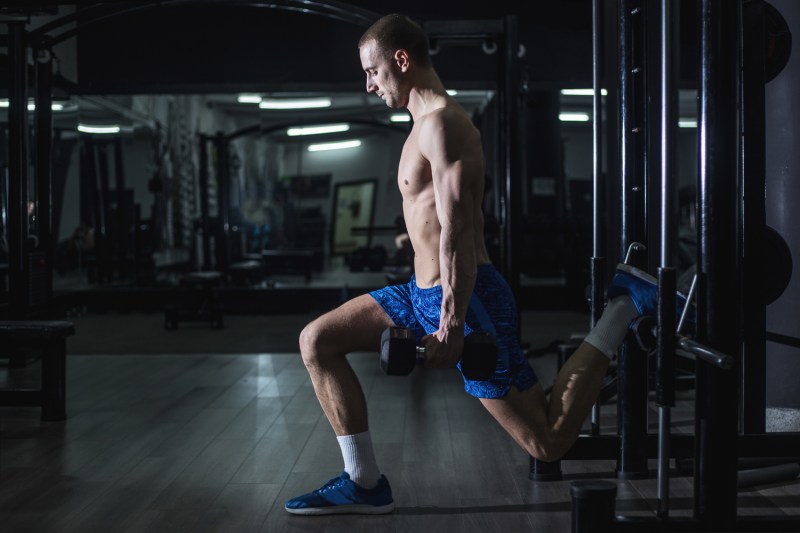
Lunges are great for strengthening your entire lower body, including your glutes. This variation requires more glute activation, so it’s a perfect exercise for increasing glute strength. You can do it at home with dumbbells and a standard step.
Equipment: Step or platform and dumbbells
Execution
- Stand on a step or platform with a dumbbell in each hand.
- Engage your core as you step one foot back off the step and drop into a deep lunge. Your front knee should be aligned with your toe, and your back knee should almost touch the ground.
- Your torso should be tilted forward about 20 degrees, hinging from the hips. Maintain a straight back.
- Push through the heel on the step to return to the starting position.
- Complete 30 reps, alternating sides.
Kettlebell swings
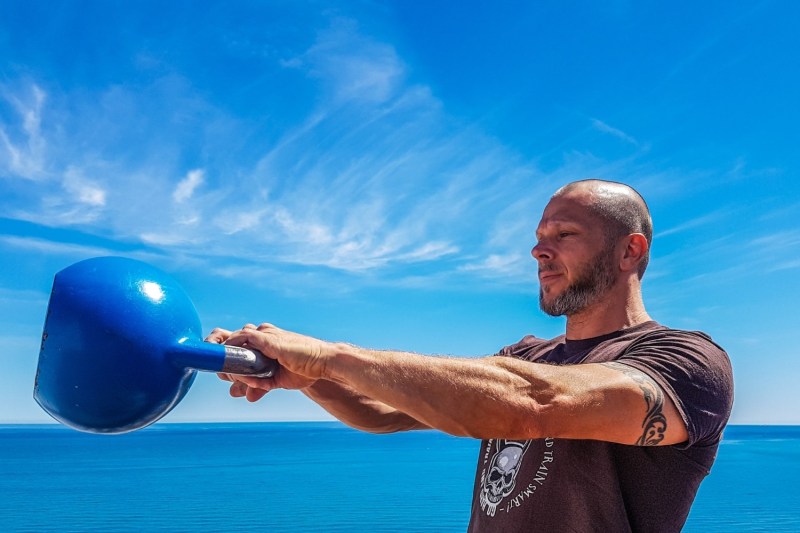
Kettlebell swings are a fun, dynamic, total-body move. Though it looks like an upper-body exercise, the true power of the swing should come from your hips and glutes.
Equipment: Kettlebell
Execution
- Stand tall with your feet about 10 inches wider than hip-width apart, gripping the handle of a moderately heavy kettlebell with both hands. Your arms should be long, so the kettlebell is hanging down in front of your body.
- Allow a soft bend in your knees, but keep your heels planted.
- Engage your core and glutes while you press through your heels and explode through your hips to drive the kettlebell upward until it’s roughly chest height and your arms are fully extended.
- Control the kettlebell as it descends, loading your glutes. It should swing backward behind your legs somewhat.
- At the end of the arc of the swing, pop your hips forward to drive the kettlebell back up to chest height.
- Complete 15 reps.
Other benefits of glute exercises for men
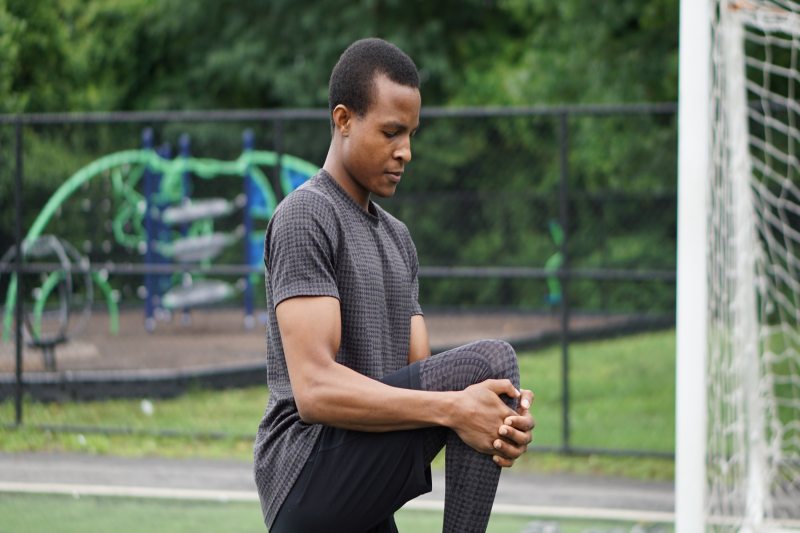
While we have been focusing on glute exercises with an eye on building that perfect butt, there are plenty of other benefits to working on your glutes other than just giving you a great booty.
- Reduce back pain: If you are having back pain, especially in your lower back, working on your glutes can give you some relief. Glute exercises help build up strength in your buttocks, which also helps support the muscles in your lower back.
- Improve your posture: By building up your glutes, you can help them strengthen the muscles in your back, which can help you stop slouching.
- Reduce knee pain: Strong glutes help stabilize your whole lower body, which can reduce the force that goes on your knees and hamstrings. This helps lower any stress put on your knee joints, lessening the risk of knee pain.
Editors' Recommendations
- Working out on keto: Maximize your fitness plan with this handy guide
- How to do a goblet squat: Your complete guide
- The 28-day calisthenics challenge: A complete guide
- Sound therapy to improve your workouts: does it really work?
- Anyone can do Chris Hemsworth’s 15-minute resistance band workout



